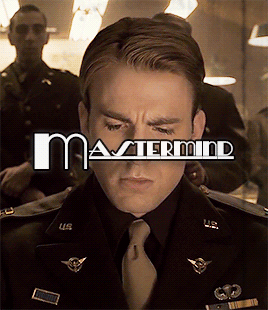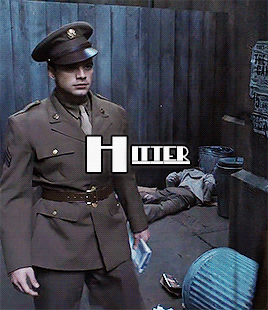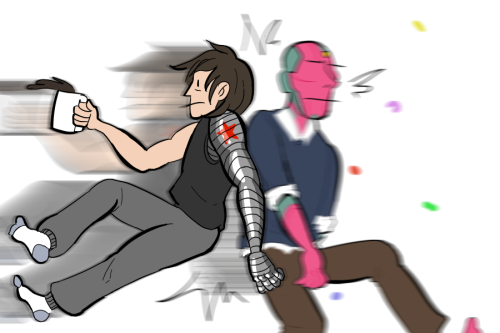Thinking About This Panel From Thunderbolts (2023) #2 Today.

Thinking about this panel from Thunderbolts (2023) #2 today.
Bucky tearing down the Outer Circle was known in the supervillain community, and he’s (conveniently, in this case) considered one of them now. What’s really interesting to me is Nefaria’s comment to Natasha, “what a delight to see you back among your proper peers.”
They operate in such morally grey areas that it’s plausible for them to just waltz into the Hellfire Club with an invitation. And even if it’s just making small talk, I like the idea of villains being relieved that Nat and Bucky might finally stop coming after them.
Which they won’t. They’re just going do it in matching evening wear.
More Posts from Lostinthewanderingblue and Others






Vintage Leverage. The post-war economy boom provides many advantages for soldiers coming home and their families, but it also increases the number of companies, as well despicable individuals, who prey on innocents. Veterans who were promised education and business loans, but fell victims to scams; women losing their jobs on false pretenses; families robbed of insurance money. They had no one to turn to, until a group of former soldiers assembled an unusual team specializing in recovering compensation for their victimized clients. Staging elaborate cons, they provide… leverage.
sometimes i watch golden girls and i just tear up remembering everything each cast member did for the queer community
estelle getty lost her nephew to AIDS and moved in with him during the last months of his life to take care of him. she started a foundation that cares for people affected by AIDS that's still there to this day. she saw one of the writers on her show was queer, walked right up to him and said "you're one of us!" and promised to protect him. she put her career on the line to become an outspoken ally of AIDS patients at a time when it would've been career suicide
bea arthur was a staunch gay and trans ally who donated a lot of her time and money to helping homeless lgbt youth. when she died, she left them thousands of dollars to stay afloat after she was gone. she was incredibly socially active in the queer community!
rue mcclanahan was a staunch advocate of marriage rights for gay couples and openly devoted her time and money for the fight for equality. she also openly participated in queer spaces and loved the community with her entire heart. she was intimately aware of gay mens' particular love for her character blanche and she fully embraced it
everybody knows by now about betty white's activism, but i'll say it anyway. not only did she join the fight for marriage equality, but she was a great mother to her lesbian stepdaughter. she participated in anti-bullying campaigns specifically against lgbt youth. she accompanied liberace to events because it wasn't safe for him to be out. she loved us and she fought for us just like the others
all four of them did SO MANY amazing things for us, and it makes me happy that we had people like them -- that we still do in people like dolly parton! we didn't deserve them. i wish i could've met all of them and told them how grateful i am!
no more "steve rogers doesn't know modern technology." embrace "steve rogers has no fucking clue what's a realistic timeline for technological advancement is." this guy used a telegraph one day and a hologram the next. his first introduction to the present was tony stark. he's never lived in a world with an ethernet cable. he doesn't know what the fuck an ipod nano is. if you showed him something supposed to be a groundbreaking impressive invention he'd just be like "oh neat. regular future stuff. okay." steve rogers with the tech awareness of a gen alpha kid. if you showed him a cd rack he'd have to think about it.
Cameron Klein, Sharon Carter, Sam Wilson, Natasha Romanoff- at the epicenter of all of them, the conspiracy of Steve's disappearance and their collective rising suspicion.
steve laughing with the howlies like he never did with the avengers. -10000 psychic damage
Please appreciate my first real fanvideo for the Leveage OT3 set to Flaws by Bastille! I'm pretty proud of it and my Leverage Secret Santa giftee (@nickelkeep) seemed to think it was pretty swell!
You can also bookmark this fanvid on AO3!
Fury: So Steve, it’s great that you brought this random guy with you and Natasha to my ultra-secret bunker that even Natasha didn’t know about, how do you know him again?
Steve: Sam and I met in a park last week and then I visited him at his job one time and then Natasha and I went to his house when we were fugitives and then we all broke into Fort Worth together
Steve: I also put Sam down as my next of kin in case I get horribly injured or anything. Just so you know
Fury: …
Steve: I’d also like for Sam to be an Avenger




3. Bargaining
Bucky in the Army, part I
When a draftee got his notice to report, he was expected to show up at his local draft board on a specified date. http://arcweb.sos.state.or.us/pages/exhibits/ww2/services/pdf/induct5.pdf (This links to a .pdf of a helpful pamphlet designed by Oregon officials for potential draftees, and outlines the induction process, as well as covering common questions.) Once there, he would receive a physical examination and fill out some paperwork. If he passed the physical, and couldn’t (or didn’t) claim a deferral on the basis of one of the few exempt categories, he was sent home with a grace period of about 21 days to set his personal affairs in order—arrange for payments of personal financial obligations, set up a power of attorney, and similar tasks. At the end of those 21 days (it might be a little longer, depending on delays in the training system, but that was the standard), he was expected to report to his assigned Army Reception Center (or Naval Training Station, but Bucky is not a Navy man, so we’ll ignore the Navy from now on out). At the Army Reception Station, draftees spent up to 7 days undergoing testing, were issued uniforms, were barbered to suit the army’s standards, started the necessary vaccinations, and were assigned to the army posts where they would undergo their basic training. At this point I’m going to break into the schedule to talk about how the US Army was organized in World War II. A numbering system was set up for https://en.wikipedia.org/wiki/Divisions_of_the_United_States_Army army divisions (the typical US Army division now averages 17,000-21,00 soldiers, and is commanded by a major general, for those not experienced military details) in 1917, during World War I. Numbers 1-25 were Regular Army divisions—the Regular Amy was the US peacetime army, which was quite small at that time. Numbers 26 through 45 were for National Guard units; and Numbers 46 through 106 were the Army of the United States (with some exceptions, like the 82nd and 101st Airborne, which became Regular Army divisions when they switched from straight infantry to airborne infantry.) The National Guard units already had the necessary organizational system in place (although many officers weren’t up to their wartime jobs and were replaced later), but to staff all those new divisions, the army took a cadre from an existing division—usually around 1300 men and officers. This core group would start training as the recruits were collected and began basic training. The Army also started pulling the necessary officers from officers in the existing Reserves (my father was one of these, as he did 4 years of ROTC to get through college in the Great Depression), ROTC programs, the Army’s own Officer Training Corps, and officers awaiting reassignment for one reason or another. At this point, the division would be formally activated, so it could receive its new recruits, and this expansion would continue until the division reached full strength. The entire time the US was fighting in World War II, it was also continuously training new soldiers, and for much of the time it was forming new divisions. http://www.historyshotsinfoart.com/USArmy/backstory.cfm This is what training involved for these new soldiers: 17 weeks of basic and advanced training (Basic is where they learn to be soldiers; Advanced training is where they learn their particular specialty—artillery, infantry, armored, or the support units and special skills.) 13 weeks of unit training (This is where they learn to work as a group.) 14 weeks of combined arms training and large-scale exercises (These would be division level exercises.) 8 weeks of final training (They have now been training 52 weeks—after the first 17 weeks all of it has been in the same unit, with the same people; they will have become very attached to each other, which is important in keeping an army working well.) At this point, they’d do some more training—multi-division exercises. The Army’s first big operation outside of the Pacific Theater was Operation Torch—in invasion of North Africa. Not all the troops involved had gone through this full regime of training, and the lack showed. The troops that invaded Sicily and Italy had the chance for more training. After this, the division traveled to a Port of Embarkation, and went overseas. If it was possible, they trained some more, usually for the specific mission they would undertake. So how long has Bucky been in the Army? If he was called up in early 1942, possibly while waiting for his enlistment paperwork to be finalized, he probably went into training in late February or March—which would mean embarkation leave (this would be about 10-15 days, depending on the travel involved—no flying, so they went everywhere by train, pretty much) in May or a little later would not be unreasonable. This fits pretty well with CA:TFA. So how did Bucky get to be a sergeant? Nowadays, the army has training programs for its noncommissioned officers, and a soldier has to have a certain amount of time in the service, and a good record to get into these programs. In World War II, they were still operating on the old-school principle of promoting sergeants from inside a unit, and they used a variety of ways to select them. One would be pre-enlistment skills and training—if a man was able to type, handle bookkeeping and other clerical tasks, he would be in a position to help handle the amazing amount of paperwork running an army unit requires. Another important factor might be how well he’d absorbed basic military skills, and how well he did in helping his fellow-soldiers along. Those who were natural leaders, as the phrase goes, might also be promising candidates. Ideally, you wanted someone who combined all of these to some degree, and who was comfortable with military discipline and methods. We don’t know a whole lot about what Bucky did between the time he finished school and went to war, but in those 6 or 7 years he may well have acquired skills the Army saw as useful in an NCO. So at some point between starting his unit training and going on his embarkation leave, the US Army saw they had a useful man in James Buchanan Barnes, and made him a sergeant, responsible for the training and lives of his fellow-soldiers, and for making sure the officers over him have the help they need to get things done.
(Need I say that, like everyone else, I have headcanon ideas about what Bucky did between the time he left school and joining the army? For later posts…)
Next post I’ll give some details about what Bucky would have gotten into once he got on board ship to head out to the shooting part of the war. Books and such may be recommended. *Link goes to a .pdf file
Also, I really hate Tumblr’s insistence on saving me from the burden of hand-inserting a link. Especially since their system works so well on a tablet.
-
 crabsarethepinnacleofevolution liked this · 1 month ago
crabsarethepinnacleofevolution liked this · 1 month ago -
 chthonic-dionsysos reblogged this · 1 month ago
chthonic-dionsysos reblogged this · 1 month ago -
 tenaciousnightruins liked this · 2 months ago
tenaciousnightruins liked this · 2 months ago -
 aberrations-reality reblogged this · 2 months ago
aberrations-reality reblogged this · 2 months ago -
 xochiquetzel liked this · 2 months ago
xochiquetzel liked this · 2 months ago -
 treesramblings reblogged this · 2 months ago
treesramblings reblogged this · 2 months ago -
 superherolover9 liked this · 2 months ago
superherolover9 liked this · 2 months ago -
 ropegrl reblogged this · 2 months ago
ropegrl reblogged this · 2 months ago -
 them1rax liked this · 2 months ago
them1rax liked this · 2 months ago -
 mufflon-rants liked this · 2 months ago
mufflon-rants liked this · 2 months ago -
 cuckoobirdy liked this · 2 months ago
cuckoobirdy liked this · 2 months ago -
 sweetpumpkinpieinwithcoffee reblogged this · 2 months ago
sweetpumpkinpieinwithcoffee reblogged this · 2 months ago -
 burninblood reblogged this · 2 months ago
burninblood reblogged this · 2 months ago -
 werebothdoingareallygoodjob reblogged this · 2 months ago
werebothdoingareallygoodjob reblogged this · 2 months ago -
 missmorwen reblogged this · 2 months ago
missmorwen reblogged this · 2 months ago -
 thewildwestpyro liked this · 2 months ago
thewildwestpyro liked this · 2 months ago -
 sweetpumpkinpieinwithcoffee reblogged this · 3 months ago
sweetpumpkinpieinwithcoffee reblogged this · 3 months ago -
 sweetpumpkinpieinwithcoffee liked this · 3 months ago
sweetpumpkinpieinwithcoffee liked this · 3 months ago -
 eustaciavye28 reblogged this · 3 months ago
eustaciavye28 reblogged this · 3 months ago -
 andthentheresanne liked this · 3 months ago
andthentheresanne liked this · 3 months ago -
 kunikidasssss liked this · 3 months ago
kunikidasssss liked this · 3 months ago -
 diywata liked this · 4 months ago
diywata liked this · 4 months ago -
 picklezdoezartz liked this · 5 months ago
picklezdoezartz liked this · 5 months ago -
 acciowriting liked this · 5 months ago
acciowriting liked this · 5 months ago -
 royal-bard liked this · 5 months ago
royal-bard liked this · 5 months ago -
 taralkariel reblogged this · 5 months ago
taralkariel reblogged this · 5 months ago -
 katebishopofearth reblogged this · 5 months ago
katebishopofearth reblogged this · 5 months ago -
 katebishopofearth liked this · 5 months ago
katebishopofearth liked this · 5 months ago -
 elinka0607 liked this · 5 months ago
elinka0607 liked this · 5 months ago -
 nimeanlion96 liked this · 5 months ago
nimeanlion96 liked this · 5 months ago -
 nmvord liked this · 5 months ago
nmvord liked this · 5 months ago -
 queen2234 liked this · 5 months ago
queen2234 liked this · 5 months ago -
 mostlymarvelsstuff reblogged this · 5 months ago
mostlymarvelsstuff reblogged this · 5 months ago -
 sy-55 liked this · 5 months ago
sy-55 liked this · 5 months ago -
 blacklag00ns liked this · 5 months ago
blacklag00ns liked this · 5 months ago -
 redroom-romanoff liked this · 5 months ago
redroom-romanoff liked this · 5 months ago -
 artemisarroxvolkov liked this · 5 months ago
artemisarroxvolkov liked this · 5 months ago -
 lynlee494 reblogged this · 5 months ago
lynlee494 reblogged this · 5 months ago -
 debinthewind liked this · 5 months ago
debinthewind liked this · 5 months ago -
 steelcoldsoldier reblogged this · 5 months ago
steelcoldsoldier reblogged this · 5 months ago -
 sleeplingsupernova liked this · 5 months ago
sleeplingsupernova liked this · 5 months ago -
 woodswandarer liked this · 5 months ago
woodswandarer liked this · 5 months ago -
 blubblesandink liked this · 5 months ago
blubblesandink liked this · 5 months ago -
 winterscrump reblogged this · 5 months ago
winterscrump reblogged this · 5 months ago -
 winterscrump liked this · 5 months ago
winterscrump liked this · 5 months ago -
 xii-bravo liked this · 5 months ago
xii-bravo liked this · 5 months ago -
 froggreencoffee liked this · 5 months ago
froggreencoffee liked this · 5 months ago -
 seraisntsmart liked this · 5 months ago
seraisntsmart liked this · 5 months ago




